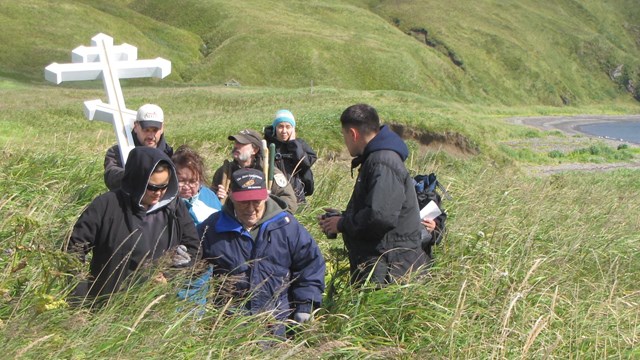
NPS Photo / Hubbard Collection
World War II was a time of unprecedented change in the Aleutian Islands. Beginning with the Japanese attack on Dutch Harbor in 1943, the stage for many stories would be set: Young servicemen traveled from around the country to aid in the war effort. Unangax̂ residents of Attu would be captured by Japanese forces and held as prisoners for the duration of the war. Other Unangax̂ in the Aleutian Islands would be forcibly relocated to subpar "duration villages" where they struggled to live and preserve their culture. All three groups would see enormous loss of life. Amid the stories of tragedy, death, and injustices of the war is the remarkable spirit of resilience. Despite the horrors they faced, servicemen, Attuan villagers, and Unangax̂ evacuees would all find community in those beside them and rely on their perserverance to carry them through a historic era of loss. Unangax̂ Stories
Unangax̂ History & Culture
Unangax̂ people have lived in the Aleutian Islands for 4,000 years, cultivating a rich culture built on community and subsistence. 
Unangax̂ Evacuation
During WWII, some Unangax̂ were forcibly relocated from their homes to "duration villages," where these communities struggled to survive. 
Attuans' WWII Experience
Residents of Attu, the westernmost Aleutian island, had an especially tragic wartime experience as prisoners of Japanese forces. 
Unangax̂ Restitution
After suffering injustices throughout WWII, the Unangax̂ community came together to advocate for restitution from the US government. 
The Lost Villages
Biorka, Kashega, and Makushin: three villages surviving centuries of change only to disappear during World War II. Military Stories
Bombing of Dutch Harbor
Six months after the attack on Pearl Harbor, Japanese aircraft struck Dutch Harbor naval base and the nearby town of Unalaska. 
The Invasion of Kiska
On June 7, 1942, the Japanese invaded the Aleutian island of Kiska. At its height of occupation 6,800 Japanese personnel were on the island. 
Battle of Attu
Lasting 18 days, the Battle of Attu was one of the deadliest battles of World War II, but it remains one of the least well-known. 
Research Portal
Browse publications, primary sources, look for veterans, and more through this research portal. 
Aleutian Servicemen
The pilots, sailors, and soldiers of the Aleutian Campaign went out into the treacherous Aleutian waters and skies. Discover their stories. |
Last updated: October 4, 2024
